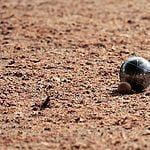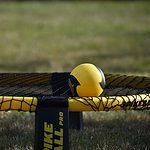Ever wondered just how big a pickleball court really is?
The dimensions of this unique playing surface might surprise you. Understanding the size specifications of a pickleball court is crucial for players looking to enhance their game and strategize effectively.
Before you step onto the court, it's essential to grasp the exact measurements that shape the pickleball experience.
Key Takeaways
- Regulation pickleball courts are 20 feet wide and 44 feet long.
- The net height varies from 34 to 36 inches across the court.
- A 7-foot non-volley zone adds strategic depth to gameplay.
- Court lines are crucial for delineating boundaries and guiding player movements.
Pickleball Court Dimensions Explained
When setting up a pickleball court, ensure the dimensions are accurate to create a fair and enjoyable playing experience for all participants. The standard pickleball court measures 20 feet in width and 44 feet in length, providing ample playing area for strategic moves and player movement.
The net height is set at 36 inches at the sidelines and 34 inches in the middle, allowing for proper gameplay and visibility across the court. A crucial element of the court is the 7-foot non-volley zone in front of the net, which prevents players from making smashes close to the net, enhancing the game's dynamics.
Additionally, the court features clearly marked service courts on both sides, ensuring that serves are made accurately within regulation size. Understanding these pickleball court dimensions is vital for players to stay within the boundaries, utilize the non-volley zone effectively, and position themselves for optimal gameplay at the back of the court.
Understanding Pickleball Court Size
In grasping the essence of pickleball court size, envision a standard court measuring 20 feet in width and 44 feet in length. This rectangular playing area is divided by boundary lines, with a net running across the middle to separate the court into two equal halves. The net stands at a height of 36 inches on the sidelines and 34 inches in the middle, creating a slight dip to allow for better gameplay visibility.
When playing on a pickleball court, players must be aware of the non-volley zone, a 7-foot area surrounding the net where volleys aren't allowed. The court also features distinct right and left service courts, akin to those found in doubles badminton. These designated areas ensure that service is conducted properly and fairly during a match.
Understanding the dimensions of a pickleball court is crucial for players to navigate the playing area effectively, adhere to the rules, and enjoy a competitive game with their opponents.
Dimensions of a Pickleball Court
To comprehend the dimensions of a pickleball court, envision a compact playing area measuring 20 feet in width and 44 feet in length, featuring specific markings and zones for strategic gameplay. The net height stands at 36 inches at the sidelines and 34 inches at the center, dividing the court into right and left service courts.
In front of the net lies the critical 7-foot Non-Volley Zone, commonly known as the kitchen, where players can't volley the ball. The court's 2-inch boundary lines clearly outline the playing area, ensuring shots land within bounds.
Whether engaging in singles or doubles play, the court's dimensions remain constant, offering a standardized experience. From the court measurements to the court surface, every aspect is meticulously designed to enhance gameplay, with clear demarcations for out-of-bounds space.
Understanding the dimensions of a pickleball court is fundamental to master the intricacies of this fast-paced and engaging sport.
Size Specifications of Pickleball Courts
The preciseness of pickleball court size specifications ensures a standardized playing area for competitive matches. When considering the size of a pickleball court, several key dimensions come into play to guarantee a fair and regulated playing environment:
- Regulation Dimensions: A standard pickleball court is 20 feet wide and 44 feet long, meeting the requirements set by USA Pickleball for official matches.
- Net Height: The net height on a pickleball court is set at 36 inches at the sidelines and 34 inches in the middle, maintaining consistent gameplay and fairness for all players.
- Non-Volley Zone: The court includes a 7-foot non-volley zone in front of the net, ensuring that players don't execute volleys from this area, promoting strategic and skillful play.
These specifications, along with the delineation of sidelines, baselines, centerline, and service areas, contribute to a well-defined playing space that adheres to the standards of competitive pickleball.
Pickleball Court Measurements Unveiled
Entering the realm of pickleball court measurements reveals a structured arena that adheres to precise specifications for competitive play. A standard pickleball court is 20 feet wide by 44 feet long, similar in size to a doubles badminton court. The net height stands at 36 inches at the sidelines and 34 inches in the middle, essential for fair gameplay.
One distinctive feature is the 7-foot non-volley zone in front of the net, where players can't hit volleys. The court is meticulously striped to define the right and left service courts, ensuring accurate serving during matches.
The layout of the pickleball court, with its specific dimensions and pickleball lines, creates a strategic space for players to showcase their skills. Understanding these measurements is fundamental for players looking to excel in the dynamic world of pickleball.
Exploring Pickleball Court Size Details
Amidst the structured dimensions of a standard pickleball court lies a precise layout that defines its strategic playing space. The pickleball court size isn't just about the length and width but also includes crucial details like net height, non-volley zone, and service court divisions.
Here are three key elements to consider when exploring pickleball court size details:
- Net Height Variation: The net height on a pickleball court is set at 36 inches on the sidelines and 34 inches in the middle to ensure fair and regulated play.
- Non-Volley Zone: With a 7-foot non-volley zone in front of the net, players must strategize their shots carefully to avoid stepping into this area during play.
- Compact Playing Area: Similar in size to doubles badminton courts, pickleball courts provide a compact yet dynamic space for players to showcase their skills while adhering to the regulations set forth for this fast-paced game.
Understanding these dimensions and adhering to the court layout is essential for an enjoyable and competitive pickleball experience.
Unveiling the Size of a Pickleball Court
Exploring the specifics of a pickleball court's dimensions unveils a playing area 20 feet wide and 44 feet long, distinguishing it from a standard tennis court. This court size is in line with the USAPA regulation recommendations, providing ample space for exciting gameplay.
The net system is set at a height of 36 inches on the sidelines and 34 inches at the center, ensuring fair play. A crucial feature is the 7-foot Non-Volley Zone that extends from the net, preventing players from executing volleys close to the net.
When serving, players must be behind the baseline and aim to land the ball within the 10 by 15-foot service courts on each side of the net.
For a full playing surface, a pickleball court ideally measures 30 feet wide by 60 feet long. Whether using a portable net for temporary lines or a permanent pickleball court setup, these dimensions create the perfect stage for an engaging pickleball match.
Pickleball Court Size Breakdown
To understand the breakdown of a pickleball court's size, consider the standard dimensions of 20 feet in width and 44 feet in length for both singles and doubles play. Here's a closer look at the key elements that define the size of a pickleball court:
- Net Height: The net on a pickleball court stands at 34 inches at the center and 36 inches at the sidelines, ensuring fair gameplay for all participants.
- Non-Volley Zone: A 7-foot non-volley zone in front of the net acts as a buffer to prevent players from hitting volleys too close to the net, adding a strategic element to the game.
- Court Lines: Typically 2 inches wide, the court lines not only mark the boundaries of the court but also delineate the playing areas, guiding players during intense rallies.
Understanding these dimensions, net heights, non-volley zones, and court lines is crucial for players to navigate the pickleball court effectively and enjoy the game to its fullest potential.
Analyzing Pickleball Court Dimensions
Having grasped the standard dimensions and key elements of a pickleball court, let's now dissect the specifics of analyzing its dimensions. The dimensions of a pickleball court play a vital role in ensuring fair play and an enjoyable game experience.
The court measures 20 feet in width and 44 feet in length, offering ample playing space similar to doubles badminton courts. Understanding the net height regulations is crucial, with the net standing at 36 inches at the sidelines and 34 inches in the center. This difference ensures a fair game for all players.
Additionally, the court features a 7-foot non-volley zone, clear boundary lines, and distinct service courts. By adhering to these dimensions, players can avoid disputes and maintain the integrity of the game. Analyzing the pickleball court dimensions provides a solid foundation for setting up the court correctly and promoting a competitive yet enjoyable environment for all participants.
The Exact Size of a Pickleball Court
The dimensions of a standard pickleball court measure 44 feet in length and 20 feet in width, with specific regulations for net height and designated playing zones to ensure fairness and competitive gameplay. The size of a pickleball court is crucial for maintaining the integrity of the game and providing players with a standardized playing area. Here are some key aspects to consider regarding the exact size of a pickleball court:
- Net Height: The net height is set at 36 inches at the sidelines and 34 inches in the middle, ensuring a consistent height throughout the court.
- Non-Volley Zone: A 7-foot non-volley zone in front of the net prevents players from making volleys close to the net, adding a strategic element to the game.
- Court Size Comparison: The court's dimensions are similar to a doubles badminton court, highlighting the compact yet dynamic nature of pickleball gameplay.
Understanding these pickleball court measurements and regulations is essential for players to compete effectively and enjoy the game to its fullest potential.





